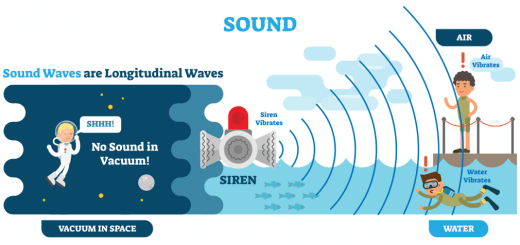Light refraction, Snell’s law, Factors affect the absolute refractive index of a medium
The light refraction can be used in analyzing a beam of white light into its components of different wavelengths due to difference of the absolute refractive index according to the wavelength of the incident light ray , so , the white light scatters into its components ( seven colours which are different in their wavelength ) and it can be seen in the soap bubbles .
Light refraction
When a light ray falls on a separating surface between two transparent media different in the optical density , Very small part of light is absorbed in the second medium , Part of the light ray reflects in the first medium , The other part passes to the second medium , changing its direction and this phenomenon is known as light refraction .
Conditions of refraction
- The two transparent media must be different in the optical density ( The velocity of light is different in the two media ) .
- The light ray must not fall perpendicular to the separating surface ( the angle of incidence ≠ zero ) .
Light refraction is the change of light path direction when it passes through two transparent media different in the optical density , Angle of refraction is the confined angle between the refracted light ray & the normal line at the point of incidence on the separating surface of the two media , Optical density is the ability of the medium to refract the light rays when they pass through it .
The light refraction obeys two laws , which are :
First law : The ratio between the sine of the angle of incidence ( sin Φ ) in the first medium to the sine of the angle of refraction ( sin Θ ) in the second medium is equal to the ratio of the speed of light ( V1 ) in the first medium to the speed of light ( V2 ) in the second medium .
The ratio is constant for the two media and is called relative refractive index 1n2 .
1n2 = sin Φ / sin Θ = V1 / V2
Second law : The incident light ray , the refracted light ray and the normal line at the point of incidence all lie in the same plane which is perpendicular on the separating surface between the two media .
From the first law : sin Φ = sin Θ
When plotting a relation between sin Φ , sin Θ , we get a straight line , Its slope represents the relative refractive index between the two media .
Slope = sin Φ / sin Θ = 1n2
Relative refractive index between two media ( 1n2 ) is the ratio between sine the angle of incidence in the first medium to the angle of refraction in the second medium , or it is the ratio between the speed of light in the first medium to the speed of light in the second medium .
When the relative refractive index between the glass and the water = 0.86 , this means that the ratio of the speed of light in the glass to the speed of light in the water = 0.86 .
Factors affect the relative refractive index between two media :
- The wavelength of the incident light ray .
- The velocity of light in the incidence medium ( the type of incidence medium ) .
- The velocity of light in the refractive medium ( the type of refractive medium ) .
The absolute refractive index of a medium
If the light ray passes from the space or the air to any other transparent medium , The ratio between sine the angle of incidence in the space ( sin Φ ) to sine the angle of refraction in the medium ( sin Θ ) equals the ratio between the speed of light in the space ( c ) to the speed of light ( v ) in the medium , this ratio is constant for the medium and it is called the absolute refractive index of the medium ( n ) .
n = sin Φ / sin Θ = V1 / V2
The absolute refractive index of the medium ( n ) is the ratio between sine the angle of incidence in the space to sine the angle of refraction in the medium , or it is the ratio between the speed of light in the space to the speed of light in the medium .
The absolute refractive index of any medium is always more than one , because the speed of light in the space is more than its speed in any other medium , The absolute refractive index has no measuring units , because it is a ratio between two similar physical quantities .
The absolute refractive index of a medium is inversely proportional to the speed of light in this medium ( n ∝ 1/v ) , When plotting a relation between ( sin Φ ) in air and ( sin Θ ) in any medium , we get a straight line , Its slope represents the absolute refractive index ( n ) for this medium .
Slope = sin Φ / sin Θ = n
When the absolute refractive index of a medium = 1.5 , this means that the ratio of the speed of light in the space to the speed of light in that medium is 1.5 .
Factors affect the absolute refractive index of a medium
The wavelength of the incident light ray , where the absolute refractive index differ according to the wavelength of the incident light ray , so , the white light disperse into its components ( seven colours different in their wavelength ) , which can be seen in soap bubbles .
Accordingly , the light refraction phenomenon can be used in the dispersion of white light into its components with different wavelengths , The velocity of light in this medium ( The type of medium ) .
The relation between the relative refractive index and the absolute refractive index
n = c / v , v = c / n ∴ v1 / v2 = n2 / n1
1n2 = v1 / v2
∴ 1n2 = n2 / n1
The relative refractive index between two media equals the ratio between the absolute refractive index of the second medium to the absolute refractive index of the first medium .
Snell’s law
From the first law of refraction :
1n2 = sin Φ / sin Θ , 1n2 = n2 / n1
sin Φ / sin Θ = n2 / n1
n1 sin Φ = n2 sin Θ
Snell’s law : The absolute refractive index for the medium of incidence times sine the angle of incidence is equal to the absolute refractive index of the medium of refraction times sine the angle of refraction .
When the light ray falls perpendicular on the separating surface , it does not suffer any refraction , according to Snell’s law ( n1 sin Φ = n2 sin Θ ) , when the light ray falls normally on the separating surface between the two media ( Φ = 0° ) then n2 sin Θ = 0 and angle of refraction ( Θ = 0° ) .
Explanation of refraction
When a light ray falls from optically less dense medium to more dense one ( from air to glass ) , the light ray refracts approaching the normal line .
This resembles a car in which one of its wheels goes through a muddy soil , which makes it slow down , while the other is free on the paved road , Therefore , the car changes its direction .
The opposite occurs , as in refraction from a more optically dense medium to a less dense one , The refracted ray refracts away from the normal .
What are the causes and uses of the light refraction ?
Light waves properties, Analysis of white light, Spectrum colours & Light intensity
Types & Laws of light reflection, Regular & Irregular reflection of light
Properties of light interference and light diffraction
Light refraction effects, Law of light refraction, Mirage & Apparent positions of objects












